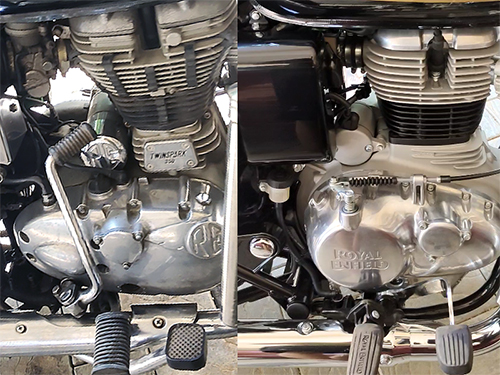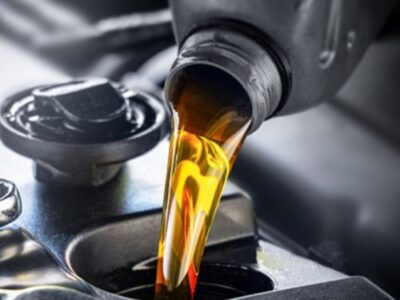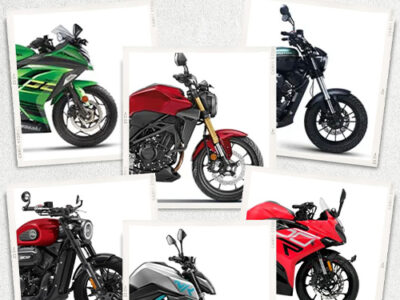
|
Getting your Trinity Audio player ready...
|
Long story short: There has been a lot of discussion and debate after the launch of the new Royal Enfield Bullet 350 about whether the new or discontinued Royal Enfield Bullet 350 are better. Let’s settle the dust regarding this.
Hello to all, myself Hiran Narayanan, the owner and the chief content writer in Bikeleague India. It has been a long time since I planned to write an article for the editorial section, which was bereft of ideas. Suddenly, a eureka moment came to my mind as I had purchased a new Royal Enfield Bullet 350 a month back.
I have owned a Royal Enfield Bullet 350 ES for over six years and have ridden it for around 60,000 km. Since I have ridden both models, why should I not contribute to my website? So, I decided to share my experience owning both generations of Bullet 350. Here, I will dissect every aspect of the motorcycle of both generations in detail.
Comparison between New Royal Enfield Bullet 350 vs old Bullet 350
1. Engine of old & new Royal Enfield Bullet 350
The most substantial change lies in the heart of the motorcycle, i.e., the engine. The new Royal Enfield Bullet 350 ditches the old 346cc Unit Construction Engine (UCE) for a more refined 349cc J-platform engine.
This engine, shared with the Meteor 350 and Classic 350, offers a slight bump in power: 20.2 bhp (New) vs. 19.1 bhp (old). It retains a similar torque (27Nm). Hence, the result is smoother performance and reduced vibrations plaguing older Bullets.
The new Bullet 350 is butter-smooth and almost does not feel like a cruiser. The rugged feel of a cruiser is virtually absent in the new Royal Enfield Bullet 350. This is what purists will surely hate. Another great thing about the new Bullet 350 is the excellent amount of power in the higher rev range, especially after the 60km/h mark, which the old Bullet 350 lacks.
2. Fit & Finish
The fit and finish of the new Bullet 350 point towards a noticeable upgrade in fit and finish. Parts, switches, footrests, etc, feel more solidly built, with tighter gaps and less misalignment. The paint job is considered more consistent and chip-resistant than older models with many colour options. There are many options to add company accessories to the model, which is a real boon.
The fit and finish in older Bullet could be hit-or-miss, with some users reporting loose panels, uneven gaps, and paint quality issues. However, this “rough around the edges” feel also contributes to the old-school charm that some riders appreciate. There are only limited accessory options from the company; hence, we need to rely on aftermarket ones.
3. Electrical System
The old Bullet used a magneto to generate a spark, and minimal lighting and kickstart are required to start the engine. The new Bullet 350 utilizes a battery and alternator for reliable power generation and features like an electric start. Kickstart is completely avoided in all the new Bullet 350 models.
The semi-digital instrument cluster offers a combination of analogue and digital display details for better information. This includes speed, fuel level, odometer, trip meter, clock, ABS, battery indicator, etc. The USB charging port allows mobile devices to be charged conveniently. In the older generations, only a speedometer and odometer, which were analogue, and even a primary fuel indicator needed to be included.
The headlamp, tail lamp, and turn signal lamp are halogen instead of LED, which is not very future-friendly in the latest Bullet 350. However, the battery is now maintenance-free, a significant improvement, and it is standard among all new-generation models.
4. Chassis
The discontinued Bullet utilized a single downtube frame, which affected handling at higher speeds and was less rigid. The new Bullet 350’s double downtube frame is stiffer, providing better handling and stability when cornering and carrying loads at higher speeds. Higher speeds were an Achilles heel for the older generations of Bullet, which is nicely sorted out in the new one.
5. Suspension of old & new Royal Enfield Bullet 350
In the old Bullet, simpler telescopic forks have less stiffness and control, especially on uneven roads. The shock absorbers have less adjustability, offering a less compliant ride and potentially bottoming out more quickly. These oil-filled shocks are generally less effective at handling bumps and rebounds than gas-filled options.
In the latest Bullet, thicker telescopic forks provide increased rigidity and better control over the front wheel, especially during braking and cornering. They also allow for preload adjustment on the rear shocks, enabling riders to fine-tune the suspension based on weight or riding style. This can significantly improve comfort and handling.
The new Bullet 350’s gas-filled shocks are generally superior to oil-filled shocks. Gas-filled shocks offer better damping and a more comfortable ride by absorbing bumps and rebounding more effectively.
6. Ride quality & refinement
The discontinued Royal Enfield Bullet 350 is mainly comfortable at low speeds. The plush suspension could soak up bumps well on gentle rides. The single downtube frame and limited suspension adjustability resulted in a less stable feel, especially during cornering and higher speeds. The main drawback is the characteristic engine vibrations, especially at higher RPMs, which could be tiring for riders on longer journeys.
The latest Bullet 350 is comfortable at all speeds. The stiffer double downtube frame and improved suspension with adjustability offer a more planted and comfortable ride, even on uneven roads. The new engine design and rubber mounts minimize vibrations significantly, leading to a smoother ride experience.
7. Handling old & new Royal Enfield Bullet 350
The old Bullet 350 is lighter and more manoeuvrable at slow speeds. The narrower tyres and simpler chassis might have felt more straightforward to manage in tight spaces. The flex in the frame and suspension could make handling less precise, especially when cornering or encountering bumps.
The stiffer chassis and upgraded suspension in the latest Bullet 350 provide better control and inspire more confidence when cornering or manoeuvring, even at higher speeds.
While the discontinued Bullet 350 offered a certain charm with its softer ride for cruising, especially on highways. The latest Bullet 350 delivers a more balanced, confidence-inspiring riding experience, from cruising to navigating cities.
8. Braking system
Braking in the old Bullet relied on a disc brake on the front wheel and a drum brake at the rear, limiting stopping power. Rear drum brakes produced sounds and needed regular maintenance, which burdened the customer. An ABS option was available but limited to single-channel ABS, which lacked the brake performance of Dual-Channel ABS.
Another significant upgrade in the new Bullet includes disc brakes on both wheels. Additionally, ABS is standard on the new Bullet, with both single- and dual-channel options available in different variants. This results in more options for customers to choose from.
9. Maintenance & Service
In the discontinued Bullet 350, periodic adjustment of valve clearances in the engine is required due to wear and tear. Regular adjustments might be needed to maintain an optimal air-fuel mixture for smooth running and fuel efficiency. The chain requires more frequent attention.
Easier access to specific mechanical components due to a less complex design. Parts might be more readily available and potentially cheaper. The more straightforward design might be more approachable for riders who are comfortable with essential mechanical work.
The new Bullet 350 automatically adjusts valve clearances, reducing the need for manual intervention. Fuel injection (EFI) manages the air-fuel mixture, offering a more consistent and hassle-free experience. The sealed chain design requires less frequent lubrication and adjustment.
Modern features like fuel injection might require specialized tools or expertise for repairs. With more complex systems, proper maintenance might require relying on trained professionals at authorized service centres.
Discontinued Bullet 350 requires frequent adjustments but might be more accessible for DIY maintenance due to a more straightforward design. Due to the more complex systems, less frequent adjustments in the new Bullet might require relying on service centres for specific maintenance tasks.
10. Color options
The colour variants are now precisely 7 with chrome options in all six colours, and while in the most premium variant, Black Gold, there is no chrome at all. Single-channel ABS is a standard option in all variants.
At the same time, Standard Black, Standard Maroon, and Black Gold dual-channel ABS are standard. The Madras line on the fuel tank is unavailable on military black and military red colour options.
In the old generation, colour options were minimal. Dual-channel ABS was unavailable in colour variants; only single-channel ABS was a standard option.
FAQ related to Royal Enfield Bullet 350 (J series) vs Discontinued Royal Enfield Bullet 350 (UCE)
1. Is there a difference in vibration levels between the two models?
Yes, there’s a significant difference. The J series engine incorporates a counterbalancer that substantially reduces vibrations, providing a smoother ride than the UCE engine. The UCE models were known for their characteristic vibrations, which some riders found uncomfortable over long distances.
2. How does the riding comfort compare between the J series and the UCE Bullet 350?
The J series offers a more comfortable riding experience due to its reduced vibrations and improved engine refinement. This enhancement in comfort is often likened to the difference in refinement between riding a truck (UCE) and a sedan (J series).
3. Are there any notable design changes in the J series Bullet 350?
While the J series Bullet 350 retains a retro-styled design similar to its predecessor, it incorporates modern touches such as a Smiths-style clock and chrome elements. It also features a helpful digital display with a fuel gauge, clock, and two trip meters.
4. How does the build quality compare between the two models?
The J series engines are considered better built than the UCE engines. While the UCE might feel stronger due to its weight and metal construction, the J series offers a more refined and modern design.
5. Is there a difference in the engine architecture between the J series and UCE?
Yes, there’s a significant change. The J-series engine replaces the older pushrod architecture of the UCE with a more modern SOHC (Single Overhead Camshaft) setup, which improves both performance and reliability.
6. How does the overall riding experience differ between the two models?
Riders have praised the J series for its smooth performance and less complicated riding experience. It’s a preferred choice for new riders or those looking for a hassle-free ride. The UCE had its own charm and was known for a more raw and vibration-heavy experience.
7. Are there any significant technological upgrades in the J series Bullet 350?
Yes, the J series Bullet 350 comes with several technological upgrades. It features a digital display with a fuel gauge, clock, and trip meters. The engine also incorporates modern technology like the counterbalancer for vibration reduction. These features represent Royal Enfield’s commitment to enhancing the riding experience while maintaining the classic appeal of their motorcycles.
Other related articles from Bikeleague India
- Cruising bikes or cruisers – Top 10 under 5 lakhs in India
- Adventure bikes vs Touring bikes which one is the best
- RE Bullet 350
- RE Classic 350
- Royal Enfield Bikes
Our opinion
The discontinued Royal Enfield Bullet 350 embodied a raw, classic riding experience with the trademark “thump.” While charming, comfort and refinement were not its primary focus. The new Royal Enfield Bullet 350 prioritizes comfort and a smoother ride while retaining the iconic silhouette. Stricter emission regulations might slightly subdue the “thump.”
Still, the overall experience caters to a broader range of riders who value heritage and modern features. The ease of repairs and DIY in older bullets is not passed on to the new generation bullet. Also, the new Bullet technology is sophisticated, which might affect long hauls in case of a breakdown.
Conclusion
Generation Z and Alpha might be more inclined towards the new Bullet as they differ significantly from millennials, Generation X, and baby boomers. The company has many loyal fans from earlier generations who might not like the new generation. I am also in that category. However, one thing is for sure: features, comfort, accessories, and performance cannot hold me back from buying a new Bullet 350.
There is a compromise between the thump from the engines and the vintage cruiser feel from older generation bullets. In a broader sense, the company has to accommodate new generations, grow, and expand. Also, competitors offer several state-of-the-art features in their models, and Royal Enfield cannot miss out on the race.
If you have any other doubts or queries, email us at bikeleague2017@gmail.com. We are always eager to help and assist you. Also, here are several social media platforms of Bikeleague India to raise your suspicions.
















